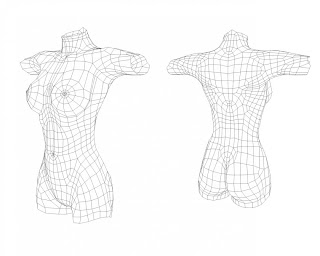Expressing Pattern
Abstract
In fashion I have always been fascinated by the way how to produce a high quality garment, especially in haute couture and traditional tailoring. They have been all about the art in cutting and making by using existing formulas of shape construction to fit around the body.
What is the pattern that constructed our body? The question gives me interest in exploring the human anatomy as garment patterns. Skins, flesh, bones, organs and muscle tissues are the pattern and structure that constructed human anatomy as reflected in technical construction of a garment.
The 4th year project allow me to have personal expression in my design. My thought on what I would like to achieve is to create a collection working close to the body, exploring design outcome through step by step experimentation and exploring any possibilities such as combining structured design with soft design and analyse how it can give a new design perspective from what used to be known for it challenge and nearly impossible.
Design Approach
For the triumph lingerie wear competition in ‘Shape Sensation’ theme, I looked at the shape and bones structure of the body anatomy. In the research I was also inspired by the 14th and 15th Century medical art illustration by Versalius, the performance of the muscle as fabrication. Each illustrations show a skinless man in muscles, the muscles lines is interesting to me because of the proportions and I started to look at anatomy pattern in life drawing. Since the research was only briefly for triumph competition, I pursuit the research further for my collection.
The first approach is by the continuing research on body anatomy from the triumph competition. Images that inspire me such as the Versalius muscle illustration gave me an idea to use muscle anatomy as my pattern. Each muscle group line is digitised using illustrator software and printed in real life human scale as a 2D map of patterns.This pattern map will be my own template that later will be re-position for example the legs pattern is position as a body or the arms pattern is use for the legs. Patterns that are traced will than be re-scaled to fit the real body. While exploring pattern position, some part of the pattern will be drafted to get the particular corner and angle stand out from the body to create the 3 dimensional form.
To be able to get the 3 dimensional form, material consideration is very important to get the perfect structured architectural shape. In contrast the soft material has to be taken into consideration because some soft material will not support the 3D shape such as knitted fabric. Each pattern will be explore on man and women body to analyze the different design outcome and what design outcome will be achieve.
Key point of approaching design
- Generating a set of pattern blocks in illustrator
- Mapping process in 2D form
- Re-positioning different pattern on different part of body
- Achieving 3D structural shape and form in hard material
- Incorporate design with soft material
- Exploring same pattern on both genders to analyze different garment design.
Methodology
- What can I use for exploration and development process?
- What will be the garment outcome?
- How to express the garment excellence performance?
To create my own pattern system to approach the design, I find the human muscle anatomy and illustrate the pattern digitally in adobe illustrator. The digital pattern is the pattern that will be used to explore tangible garment designs.
Placing different pattern blocks on different body area or mapping on the body, pattern draft than will be re-draft using pattern making method to achieve different silhouettes that can be wearable.
Each final design will be toiled using different material to see which material is best to express the garment outcome. 3D structure design will be explored using material such as woven fabric in wool, linen, denim or even PVC while Soft part in design will be examine with material such as chiffon and knitted fabrics to produce drape or body hugging garment. Using different materials can effect the whole design outcome particularly the performance is structure, texture, drape, sheer effect and sharpness.
Selected material and its use on different part of garments will give option to certain techniques of construction for example tailoring technique for most outer garment, structured part of the garment and detail such as pocket.
Aim
- What is the collection mean philosophically?
- What is the purpose of this collection?
- What can be done within the parameter of design?
- What is the expression from the design process?
This project of expressing fashion has given me the opportunities to express my understanding on how fashion dominates body image. The series of pattern is the key to help changing perception of the way body garment was built and ‘form follow function’ theory. It will be the alternative way to construct garment instead of using basic body pattern blocks. Even demonstrating design interpretation by exploring the possibilities of combining different design forms such as structural form with fluid or soft texture.
Outcome
- How will the concept communicate to the audience?
- How can I express my process as a designer beside expressing the concept?
Final garment from a process in body mapping has to be demonstrated on a real body to give evidence for its tangibility and functionality. Each garment pieces from the collection is developement from experimented shapes and forms, from one to another. Process will also be captured in a short video format to show how the collection grows in an abstract form. The collection will also be expressing the perfection in cut and technical production to exhibit the complexity and craftmanship detail in design process.













